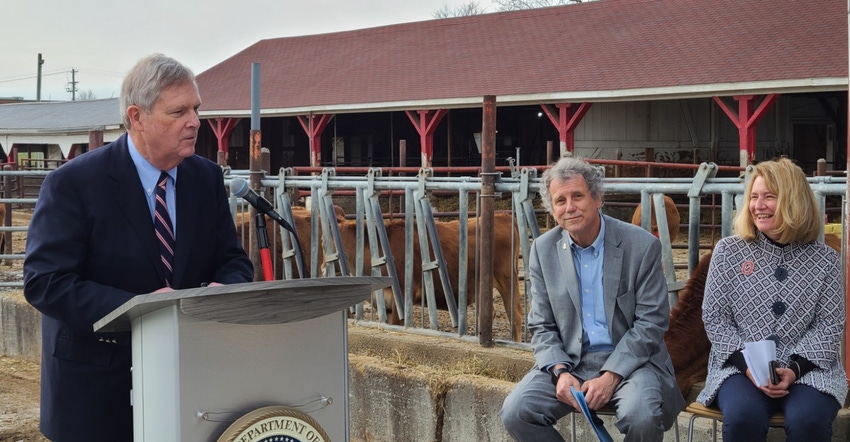
“To me, the key to resiliency in the agricultural space is a combination of conservation and innovation,” Secretary of Agriculture Tom Vilsack said, while visiting Ohio State University on Dec. 10 to announce $15 million in grants to conservation partners across the country for 19 new projects under the Conservation Innovation Grants program.
Vilsack made the announcement with Sen. Sherrod Brown, D-Ohio, after a tour of Ohio State’s Waterman Agricultural and Natural Resources Laboratory to highlight the critical role of agriculture in the nation’s economy and the administration’s investment in agricultural research.
Vilsack and Brown toured Waterman and participated in a discussion with university faculty and staff and industry stakeholders that was moderated by Cathann Kress, Ohio State’s vice president for agricultural administration and College of Food, Agriculture and Environmental Sciences (CFAES) dean.
These projects focus on helping agricultural producers mitigate the effects of climate change and increase the resilience of their operations. Conservation Innovation Grants is a competitive program that supports the development of new tools, approaches, practices and technologies to further natural resource conservation on private lands.
Through creative problem-solving and innovation, CIG harnesses the expertise, resources and capacity of partner organizations nationwide to help boost natural resource conservation on private lands and support climate-smart agriculture.
Nutrient management
Ohio State received $1.2 million to research a high-clearance robotic irrigation system for in-season nutrient management. Ohio and Iowa will be involved in evaluating the 360 High Clearance Robotic Irrigation System for in-season nutrient applications, which aligns nutrient application timing to a crop’s nutrient needs and improves irrigation efficiency, having a high probability of affecting water quality and reducing evaporation.
Vilsack explains the project will create the ability to more accurately and more efficiently apply nutrients, while also preserving and conserving water. “This is a resource and an opportunity to learn a lot about how we can improve the environment here,” Vilsack says.
Another project funded in the area targets the nutrient loading reduction through phosphorus recovery demonstration program in the Great Lakes region of Indiana, Ohio and Michigan with a $507,902 grant. The Maumee Watershed Alliance will demonstrate phosphorus recovery technologies at three different sites with the aim of illustrating 80% total phosphorus removal over extended demonstration periods.
MWA will also explore the market value of two resultant co-products — dewatered manure solids and amorphous calcium phosphate.
The collaborative effort to remove phosphorus loads from the land could have an “expansive impact on agriculture,” Vilsack says.
Additional funding priorities for this year included climate-smart strategies for water resources; soil health (focused on climate mitigation, adaptation and resilience); nutrient management; grazing lands conservation; and strategies to increase conservation adoption.
“Innovation is key to addressing the climate crisis and conserving the natural resources we all depend on,” Natural Resources Conservation Services chief Terry Cosby says. “CIG partners are using the latest science and research to come up with solutions that work for farmers, ranchers and foresters and help ensure the longevity of American agriculture.”
The national CIG program has two parts: CIG Classic and CIG On-Farm Conservation Innovation Trials. Through CIG Classic, partners develop new tools, technologies and strategies to support next-generation conservation efforts on working lands and develop market-based solutions to resource challenges.
CIG on-farm trials support more widespread adoption of innovative approaches, practices and systems on working lands. NRCS and partners collaborate to implement on-the-ground conservation activities and then evaluate their impact. In November, NRCS awarded $25 million for 18 on-farm trials projects.
Highlighting Ohio State research
Kress pointed to the construction of the Controlled Environment Agriculture Research Complex and the plans for the new Multispecies Animal Learning Center as part of the continuing innovation at Waterman. Robotic-enhanced farming and artificial intelligence research were also highlighted.
“We are so delighted to have visitors coming out to learn more about the science and the technology of our college and our focus on food, agriculture and environmental sciences,” Kress says. “Robotics are another important addition to what we can do here at Ohio State University to provide a world-class education for our students and a world-class research environment for our faculty.”
Vilsack echoed that sentiment, calling the research and education at Waterman and CFAES critical to the nation’s agricultural and environmental future.
“There’s a lot of cool things happening today, but there is nothing more cool than what we are doing right here,” he says. “The ability of young people to engage in transforming our agricultural system to support local and regional food systems, to support commodity-scale agriculture, to embrace both of those in an effort to reduce the carbon footprint of American agriculture and allow it to be a national and international leader in climate change is an exciting opportunity.
“And to be able to do it in a way that increases the bottom line for farmers, ranchers and producers, increases their ability to keep the farm and to transfer it to the next generation, is just an exciting opportunity,” Vilsack says.
About the Author(s)
You May Also Like






